Viral morphology - Study guides, Class notes & Summaries
Looking for the best study guides, study notes and summaries about Viral morphology? On this page you'll find 427 study documents about Viral morphology.
Page 3 out of 427 results
Sort by
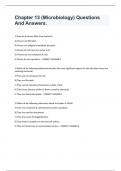
-
Chapter 13 (Microbiology) Questions And Answers.
- Exam (elaborations) • 17 pages • 2024
-
Available in package deal
-
- $11.99
- + learn more
Chapter 13 (Microbiology) Questions And Answers. 1) How do all viruses differ from bacteria? A) Viruses are filterable. B) Viruses are obligate intracellular parasites. C) Viruses do not have any nucleic acid. D) Viruses are not composed of cells. E) Viruses do not reproduce. - CORRECT ANSWER D 2) Which of the following statements provides the most significant support for the idea that viruses are nonliving chemicals? A) They are not composed of cells. B) They are filterable. C) ...
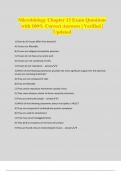
-
Microbiology Chapter 13 Exam Questions with 100% Correct Answers | Verified | Updated
- Exam (elaborations) • 16 pages • 2024
- Available in package deal
-
- $12.49
- + learn more
Microbiology Chapter 13 Exam Questions with 100% Correct Answers | Verified | Updated 1) How do all viruses differ from bacteria? A) Viruses are filterable. B) Viruses are obligate intracellular parasites. C) Viruses do not have any nucleic acid. D) Viruses are not composed of cells. E) Viruses do not reproduce. - answerD 2) Which of the following statements provides the most significant support for the idea that viruses are nonliving chemicals? A) They are not composed of cells. B) ...
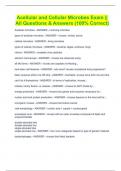
-
Acellular and Cellular Microbes Exam || All Questions & Answers (100% Correct)
- Exam (elaborations) • 8 pages • 2024
-
Available in package deal
-
- $9.69
- + learn more
Acellular and Cellular Microbes Exam || All Questions & Answers (100% Correct) Acellular and Cellular Microbes Exam || All Questions & Answers (100% Correct) Acellular microbes - ANSWER - nonliving microbes types of acellular microbes - ANSWER - viruses, viroids, prions cellular microbes - ANSWER - living microbes types of cellular microbes - ANSWER - bacteria, algae, protozoa, fungi virions - ANSWER - complete virus particles electron microscope - ANSWER - viruses are observe...
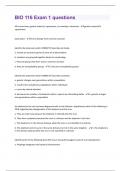
-
BIO 116 Exam 1 questions Rated 100% Correct!!
- Exam (elaborations) • 16 pages • 2023
- Available in package deal
-
- $7.49
- + learn more
All viruses have: genetic material, capsomeres, an envelope, ribosomes - genetic material & capsomeres basal taxon - first to diverge from common ancestor identify the statement which CORRECTLY describes all clades. a. include an ancestral species & some of its descendants b. members are grouped together based on morphology c. they are groups that don't share a common ancestor d. they are monophyletic groups - d. they are monophyletic groups Identify the statement which CORRECTLY descri...
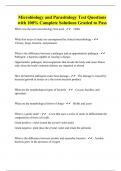
-
Microbiology and Parasitology Test Questions with 100% Complete Solutions Graded to Pass
- Exam (elaborations) • 8 pages • 2024
-
Available in package deal
-
- $13.99
- + learn more
When was the term microbiology first used - 1860s What four areas of study are encompassed by clinical microbiology - Viruses, fungi, bacteria, and parasites What is the difference between a pathogen and an opportunistic pathogen - Pathogen: a bacteria capable of causing a disease Opportunistic pathogen: microorganisms that invade the body and cause illness only when the body's immune defense are impaired or absent How do bacterial pathogens cause host damage - The damage ...

-
OSMT Exam Question and Answers 100% Solved Correctly 2024
- Exam (elaborations) • 22 pages • 2024
- Available in package deal
-
- $13.49
- + learn more
OSMT Exam Question and Answers 100% Solved Correctly 2024 Which of the following is termed as the "universal solvent?" a) acid b) base c) water d) sodium chloride - answerc) water Another term for saline is: a) water b) NaCL c) Na d)Cl - answerb) NaCl Cells in an isotonic solution will: a) swell and burst b) shrink and dehydrate c) be balanced with outer concentration d) hemolyze - answerc) be balance with outer concentration A biohazardous sharps container is used to dispose:...
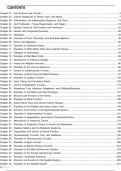
-
TEST BANK ESSENTIALS OF PATHOPHYSIOLOGY (4TH EDITION BY PORTH)
- Exam (elaborations) • 263 pages • 2024
-
- $15.49
- 2x sold
- + learn more
TEST BANK ESSENTIALS OF PATHOPHYSIOLOGY (4TH EDITION BY PORTH) CONTENTS Chapter 01 - Cell Structure and Function .......................................................................................................................... 2 Chapter 02 - Cellular Responses to Stress, Injury, and Aging .......................................................................................... 7 Chapter 03 - Inflammation, the Inflammatory Response, and Fever ..............................................

-
Virology Practice Test 32 Questions with Verified Answers,100% CORRECT
- Exam (elaborations) • 7 pages • 2024
-
- $10.49
- + learn more
Virology Practice Test 32 Questions with Verified Answers The difference between "simple" retrovirus and "complex" retrovirus is? A) "Simple" retroviruses do not cause disease B) "Complex" retroviruses contain additional genes called accessory genes C) "Simple" retroviruses do not cause tumors D) "Complex" retroviruses carry viral oncogene E) Only "complex" retroviruses produce provirus - CORRECT ANSWER B, E What is the first biosynthetic event that occurs in cells i...

-
Microbiology Chapter 13 Exam Questions with 100% Correct Answers | Verified | Updated
- Exam (elaborations) • 16 pages • 2024
- Available in package deal
-
- $14.49
- + learn more
Microbiology Chapter 13 Exam Questions with 100% Correct Answers | Verified | Updated 1) How do all viruses differ from bacteria? A) Viruses are filterable. B) Viruses are obligate intracellular parasites. C) Viruses do not have any nucleic acid. D) Viruses are not composed of cells. E) Viruses do not reproduce. - answerD 2) Which of the following statements provides the most significant support for the idea that viruses are nonliving chemicals? A) They are not composed of cells. B) ...
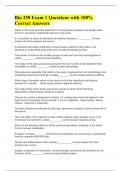
-
Bio 250 Exam 1 Questions with 100% Correct Answers
- Exam (elaborations) • 7 pages • 2024
- Available in package deal
-
- $12.99
- + learn more
Which is the most accurate statement? Correct answer anatomy has always been known to reveal the relationship between body parts It is important to study the discipline of anatomy because it _________. Correct answer all of the answers are correct Anatomical information statement correct answer anatomic information is all historical or it describes body parts and considers probable function The branch of science that studies groups of cells and how they work together is called__________...

$6.50 for your textbook summary multiplied by 100 fellow students... Do the math: that's a lot of money! Don't be a thief of your own wallet and start uploading yours now. Discover all about earning on Stuvia


